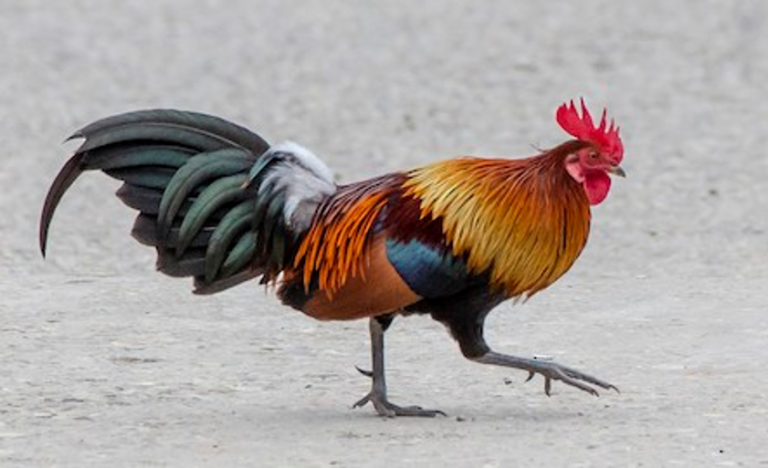Birdfinding.info ⇒ The wild ancestor of the domestic chicken remains locally common across much of its original range, where it is can be found in protected natural areas, including most of the national parks, wildlife refuges, and nature sanctuaries of northern India, Nepal, Bhutan, southern China, and southeast Asia. In Hawaii, introduced populations, most heavily hybridized with domestic chickens, are locally common on the main islands, especially in the lowlands of Kauai, where many appear to be nearly pure.
Red Junglefowl
Gallus gallus
Southeastern Asia; widely introduced across the tropical Pacific. Inhabits forests, other woodlands, and adjacent openings.
Native populations occur from northern and central India (Kashmir, Madhya Pradesh, and Andhra Pradesh) east to southern China (locally in Yunnan, Guangxi and Hainan) and south through Indochina, the Malay Peninsula, Sumatra, and Java to Bali.
Introduced populations are established on many Pacific Islands: the Philippines (throughout), northeastern Borneo, Sulawesi, the Lesser Sundas east to Timor, Palau, Vanuatu, New Caledonia, New Zealand’s North Island, Fiji, Samoa, Tonga, the Cook Islands, Moorea, Tahiti, the Marquesas, Hawaii. Most, if not all, of the introduced populations east of Indonesia have hybridized with domestic chickens to varying degrees, which confuses their current identity.
Identification
Red Junglefowl is the principal, or perhaps only, ancestor of the domestic chicken, so the general resemblance between them is strong. The male, in particular, could easily be mistaken for a bantam rooster, while the female is less similar to a barnyard hen. Both sexes have features that rarely if ever appear in their domestic counterparts, the most consistent being gray legs.

Red Junglefowl, male in roosterlike posture. (Kaeng Krachan National Park, Phetchaburi, Thailand; March 9, 2019.) © Tim Avery
The male’s plumage is colorful and complex, with several contrasting feather groups. Most prominent is its orange cape or neck-ruff, which it erects like an umbrella when displaying or sparring with rivals.

Red Junglefowl, male, showing most of its colors—note white check wattle. (Nam Cat Tien National Park, Dong Nai, Vietnam; March 15, 2017.) © Peter Ericsson

Red Junglefowl, male with orange cape partially flared—note the lack of iridescence on black feathers in this lighting. (Kaeng Krachan National Park, Thailand; February 22, 2017.) © Luke Seitz

Red Junglefowl, male in display posture, showing glossy-green wing coverts. (Kaziranga National Park, Assam, India; April 17, 2018.) © Subhadra Devi
The male’s upperparts have panels of chestnut and glossy greenish- or bluish-black, the secondaries are coppery, and the rump is white. The underparts are mostly black, with a greenish gloss in strong light.
The tail is black and wedge-shaped, with glossy greenish-black covert feathers that extend across the tail. Two of these feathers are greatly elongated and sickle-shaped, and arch over the tail.
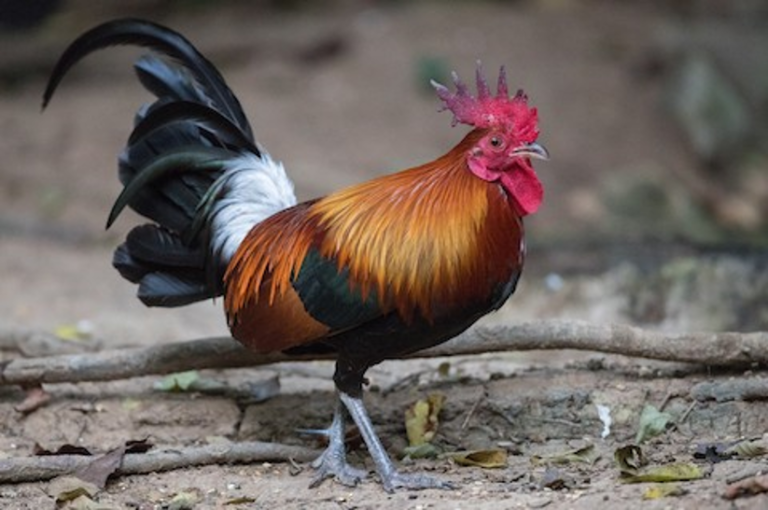
Red Junglefowl, male with wing coverts and tail appearing black. (Kaeng Krachan National Park, Phetchaburi, Thailand; February 22, 2017.) © Ian Davies
The facial skin is bare and bright red, and includes a tall comb and wattles on the throat and cheeks. In males of some populations, the cheek wattles are white.

Red Junglefowl, male with white cheek wattles. (Nam Cat Tien National Park, Dong Nai, Vietnam; March 30, 2019.) © Marc Choisy
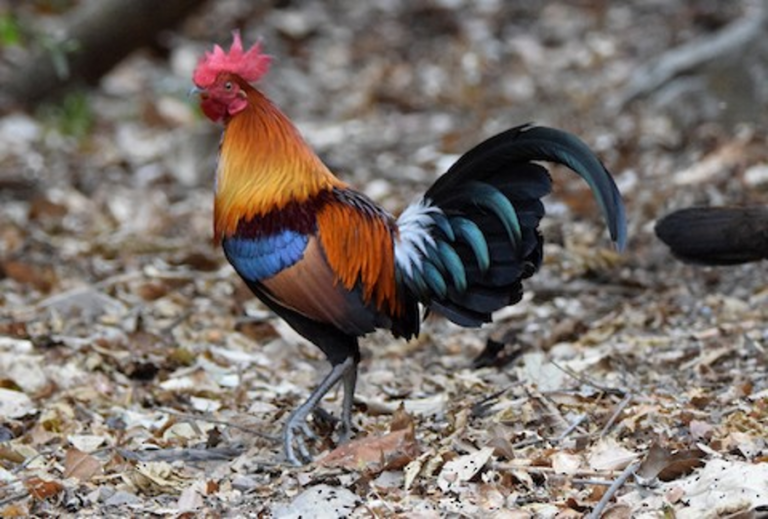
Red Junglefowl, male showing glossy-blue wing coverts. (Kaeng Krachan National Park, Phetchaburi, Thailand; March 12, 2019.) © Laura Bakken
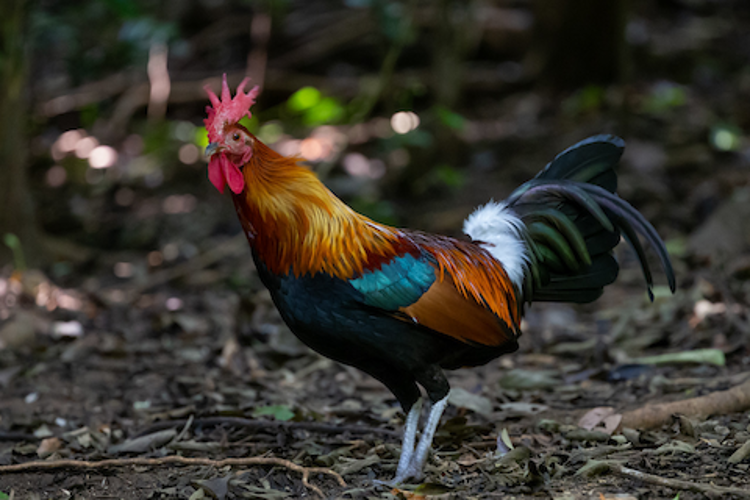
Red Junglefowl, male showing glossy-turquoise wing cooverts. (Kaeng Krachan National Park, Phetchaburi, Thailand; November 24, 2018.) © Robert Tizard

Red Junglefowl, male—apparently not full mature, based on incomplete development of comb and wattles. (Nonggang National Natural Reserve, Guangxi, China; January 6, 2017.) © Khalid Sharif

Red Junglefowl, immature male, lacking elongated tail coverts. (Kaziranga National Park, Assam, India; April 17, 2018.) © Subhadra Devi
Female differs noticeably from domestic hen in the appearance of its tail, which is long, wedge-shaped, and typically held horizontal.
Its overall coloration is medium-brown, with a blackish or dark-brown tail, pale-brown breast, dense orange and black streaks on the head and neck, and diffuse whitish streaks on the breast and upperparts.
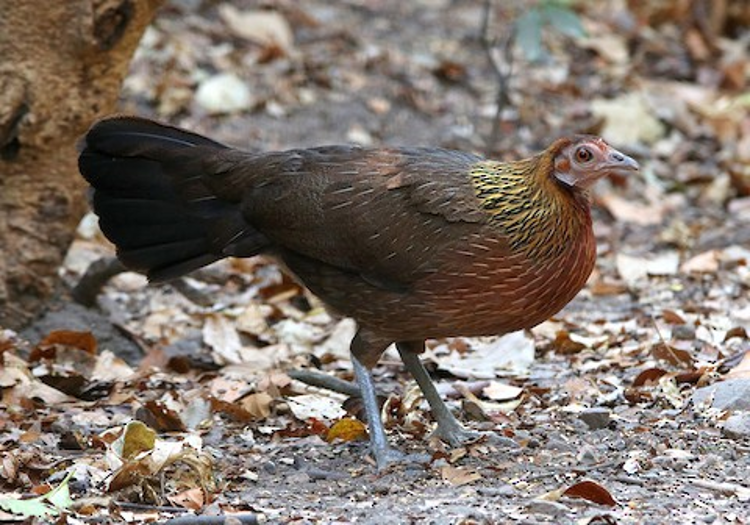
Red Junglefowl, female. (Kaeng Krachan National Park, Phetchaburi, Thailand; March 9, 2019.) © Tim Avery
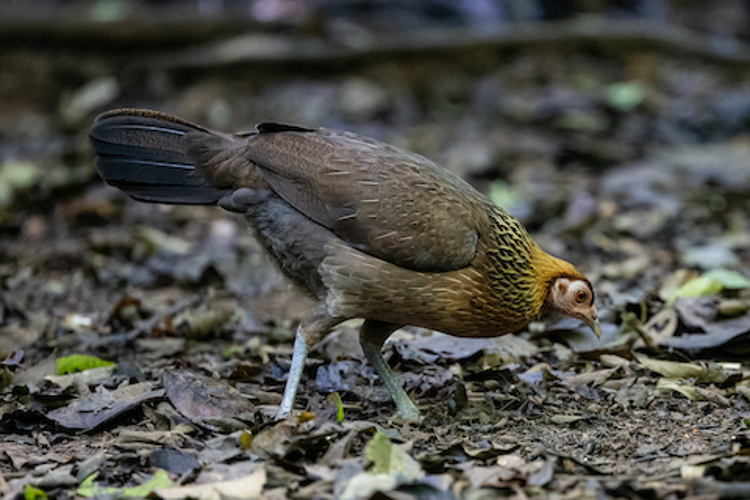
Red Junglefowl, female showing bright orange cape. (Kaeng Krachan National Park, Phetchaburi, Thailand; November 24, 2018.) © Robert Tizard
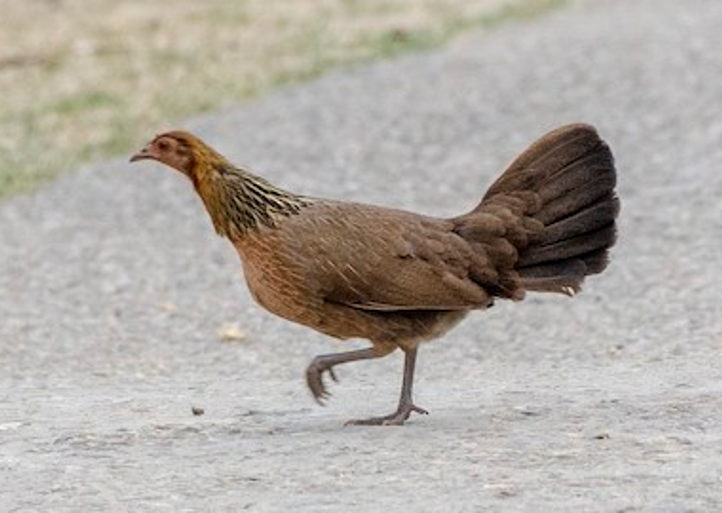
Red Junglefowl, female showing mostly brown tail held half-cocked—similar to the typical posture of a domestic chicken. (Mahamaya Forest, Jammu, India; April 8, 2018.) © Parmil Kumar
Female’s facial skin is mostly bare and dull-pink. As with males, in some populations the females have white patches on the cheeks.
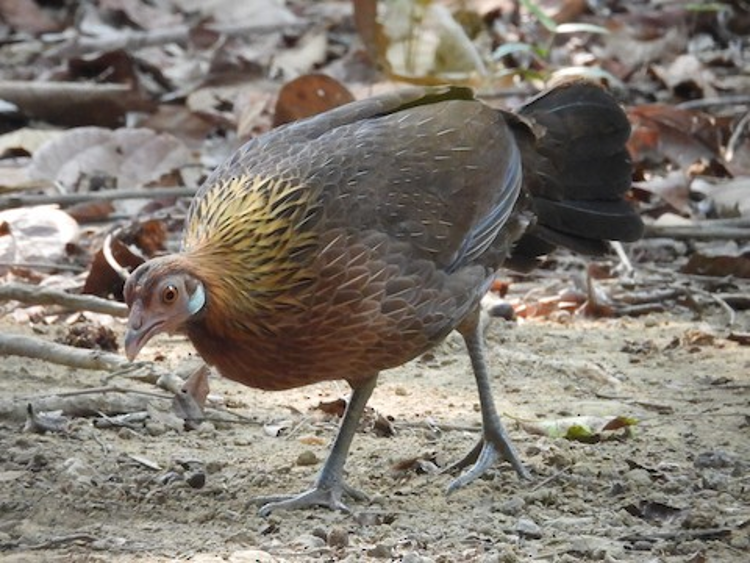
Red Junglefowl, female with white cheek wattles. (Nam Cat Tien National Park, Dong Nai, Vietnam; March 17, 2019.) © C.L. Hampton
Cf. Domestic Chicken. The distinction between Red Junglefowl and domestic chicken has become fluid and ambiguous on the many Pacific islands where hybridization has produced a full spectrum of appearances, some nearly identical to wild junglefowl and many that differ in obvious ways. In Hawaii, for example, the distinction may be a lost cause: the feral populations are not quite junglefowl or chickens anymore.
In regions where Red Junglefowl occurs without extensive hybridization, they are readily distinguishable from wild-living chickens that occur in the same areas. A general rule of thumb is to focus on the legs: Red Junglefowl has gray legs, whereas domestic chickens generally have yellow or orange legs.
Although many domestic roosters resemble male Red Junglefowl, very few have exactly the same set of intensely colored feather panels, the wedge-shaped tail, and the overarching glossy-greenish covert feathers.
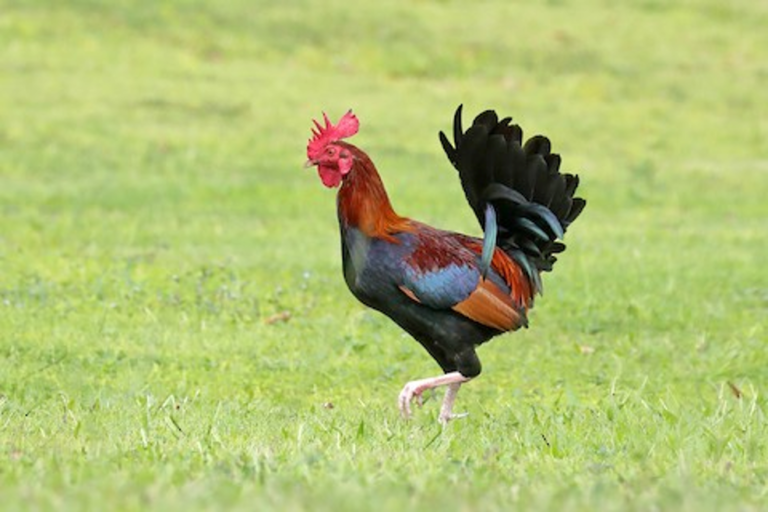
Red-Junglefowl-domestic-chicken hybrid, male showing most plumage characters of Red Junglefowl but roosterlike shape, posture, and leg color. (Waioli Park, Hanalei, Kauai, Hawaii; October 12, 2019.) © Doug Hommert
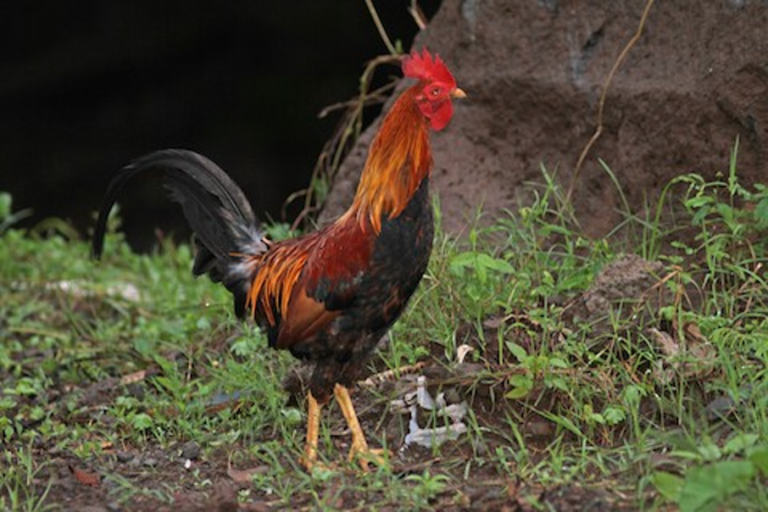
Red-Junglefowl-domestic-chicken hybrid, male showing most plumage characters of Red Junglefowl—but note yellow legs and roosterlike posture. (Grotte de Maraa, Tahiti; February 5, 2013.) © Daniel Jauvin

Red-Junglefowl-domestic-chicken hybrid, female, showing most plumage characters of Red Junglefowl but chickenlike facial skin. (Waimea Canyon, Kauai, Hawaii; December 25, 2016.) © Susan Szeszol
Most domestic hens do not closely resemble female Red Junglefowl, which can usually be distinguished by its long, wedge-shaped tail held horizontal, and the bright streaks on its neck and breast. However, as with the males, some hybrid populations have a spectrum that includes many morphologically intermediate appearances: such as medium-length tails held diagonally, and fine streaks distributed over varying portions of the neck and body.
Cf. Gray Junglefowl. Red and Gray Junglefowl have adjacent ranges and may overlap to some extent in central India. Males of the two species have entirely different plumages, but females are somewhat similar.
Female Gray Junglefowl is chicken-shaped, with a short tail that it holds partially cocked. Its tail is pale brown and barred, whereas Red’s is blackish and unmarked. Female Gray’s legs are yellow, whereas Red’s are gray. Female Gray also differs from Red in having extensive broad, white streaks on the underparts.
Cf. Green Junglefowl. Red and Green Junglefowl coexist naturally on Java and Bali, and through introductions elsewhere in Indonesia. Males of the two species have entirely different plumages, but females are somewhat similar.
Female Green Junglefowl is chicken-shaped, with a short tail that it holds partially cocked. Its plumage is dominated by a complex brown-and-black scaled pattern that varies in shape from rounded on the underparts, neck, and mantle, to angular on the wings, lower back, and rump. The shades of brown are grayer on the neck and breast, and rusty on the wings and rump—whereas female Red’s overall coloration is approximately the opposite: rustier on the neck and breast, and duller on the wings and rump.
Notes
Polytypic species consisting of five recognized subspecies. Red Junglefowl is the principal ancestor of the domestic chicken.
References
BirdLife International. 2016. Gallus gallus. The IUCN Red List of Threatened Species 2016: e.T22679199A92806965. https://dx.doi.org/10.2305/IUCN.UK.2016-3.RLTS.T22679199A92806965.en. (Accessed February 9, 2020.)
eBird. 2020. eBird: An online database of bird distribution and abundance. Cornell Lab of Ornithology, Ithaca, N.Y. http://www.ebird.org. (Accessed February 9, 2020.)
Hawaii Audubon Society. 2005. Hawaii’s Birds (Sixth Edition). Island Heritage Publishing, Waipahu, Hawaii.
McGowan, P.J.K., and G.M. Kirwan. 2020. Red Junglefowl (Gallus gallus). In Handbook of the Birds of the World Alive (J. del Hoyo, A. Elliott, J. Sargatal, D.A. Christie, and E. de Juana, eds.). Lynx Edicions, Barcelona. https://www.hbw.com/node/53485. (Accessed February 9, 2020.)
Pratt, H.D., P.L. Bruner, and D.G. Berrett. 1987. A Field Guide to the Birds of Hawaii and the Tropical Pacific. Princeton University Press, Princeton, N.J.
Raffaele, H., J. Wiley, O. Garrido, A. Keith, and J. Raffaele. 1998. A Guide to the Birds of the West Indies. Princeton University Press, Princeton, N.J.
Xeno-Canto. 2020. Red Junglefowl – Gallus gallus. https://www.xeno-canto.org/species/Gallus-gallus. (Accessed February 9, 2020.)
